We’ve all bought something online and then felt that sense of uncertainty after hitting ‘purchase’.
You know that peculiar sense of regret that’s hard to pin down? Yup, that feeling is known as post-purchase dissonance.
As a merchant, post-purchase dissonance can wreak havoc on your bottom line. Seriously, if customers regret their purchase – the odds of them shopping with you again are slim.
The good news is that with a couple of simple tactics, you can reduce post-purchase dissonance and turn dissatisfaction into dollars.
That said, it would shock you how many merchants don’t have a post-purchase strategy in place.
So, without further ado, let’s tuck in and discover how you can reduce post purchase dissonance and stick a smile on your customer’s faces.
What is Post Purchase Dissonance?
Understanding post-purchase dissonance is incredibly important for retailers. But despite most of us experiencing it, lots of eCommerce merchants struggle to define the term.
So, let’s kick off by clearly stating what we mean when we talk about post-purchase dissonance.
Post Purchase Dissonance Definition
Post purchase dissonance is the extent to which customer’s feel dissatisfied after buying a product on your eCommerce store. Post-purchase dissonance occurs for several reasons. The most common of which are:
- Customer’s may find a review that makes them reconsider their purchase
- Shoppers may discover the same product elsewhere at a lower price
- The product doesn’t meet the customer’s expectations
- Shoppers experience doubts about the trustworthiness of your business
There are many other factors that contribute to post-purchase dissonance. Each store and customer is unique. Meaning there are thousands of reasons why a customer may feel regret and go-back on their decision.
It’s also important to know that dissonance can occur at any time in a customer’s post-purchase journey. From the moment they hit ‘purchase’ until the end date of your return policy.
So, now that you know what post-purchase dissonance is, let’s discover the reasons why you need to minimize it asap.
Why Post Purchase Dissonance Matters
Minimizing post-purchase dissonance creates happier customers. Happier customers are more likely to become repeat customers. And as any successful eCommerce entrepreneur will tell you, repeat customers are where the real profit is at.
You’ve likely heard the statistic that attracting a new customer costs five times as much as retaining one (who hasn’t).
But stop and actually think about that for a second. When somebody buys from you, you’ve already done the hard work. From here on out, selling to them again is easy.
But if your customers are wracked with anxiety and regrets, they simply won’t come back. Your front-end acquisition efforts have been in vain.
Seriously think about something you bought online that you were unhappy with. Whatever it was, I’d bet you haven’t shopped with the same store since.
The sad truth is that when it comes to eCommerce marketing, most brands are overly-focused on the pre-purchase experience. Once a customer buys from them, that’s it.
But with 90% of customer’s holding onto at least one they wanted to return, how much untold damage is being done to these companies?
It’s hard to say exactly. But it does mean one thing: that optimizing the post-purchase experience represents a massive opportunity to get one up on your competitors.
6 Strategies to Reduce Post Purchase Dissonance
If you want to build a loyal customer base of repeat buyers, then you can’t solely focus on the pre-purchase experience. You need to deploy specific tactics that’ll reduce buyers remorse and boost customer satisfaction.
So, no matter if you’ve got a one product store, or a massive catalogue of items, here’s six of best remorse-crushing tactics to try:
1. Identify Why Post-Purchase Dissonance is Happening
The first and most obvious step to turning dissatisfaction into dollars is to identify where post-purchase dissonance happens for your customers.
One great strategy to achieve this is to scour your help desk. Find the common reasons that cause customers to initiate returns, refunds and chargebacks.
Then review your product descriptions, photography, size charts,shipping policy, reviews and anything else that impacts customer expectations. If you manage expectations early on, you’ll be less likely to run into disappointment down the road.
On top of analysing your support data, you can also just ask customers who return items the reasons for doing so. A simple email survey can give you actionable feedback that’ll empower you to reduce returns and dissonance at the same time.
2. Leverage a Custom Thank You Page
Most merchants opt for a generic page that displays basic information like an order summary, and billing details.
But this is a mistake.
Think about it, your thank you page is the first point of contact customers have with your brand post-purchase.
And unlike emails, almost 100% of customer’s see the thank you page. It’s an incredibly valuable landing page that you’re most likely not leveraging.
In other words, it’s a massive opportunity to banish the demons of post-purchase regret.
For example, plant retailer Feey uses their thank you page to combat post-purchase dissonance by adding trigger-based videos to the page.
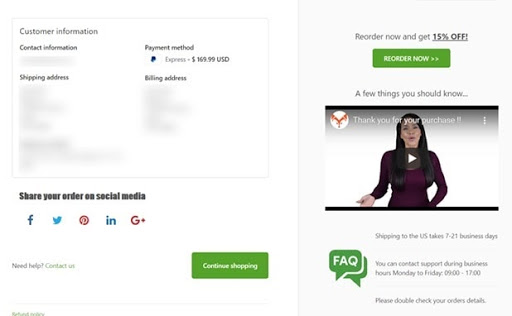
These videos welcome new customers, thank repeat customers and also share tips to care for their plants. Getting a personalized video instantly forms a bond between Feey and their customers because it’s so unexpected.
More clever tactics might be to add customer testimonials, unboxings or even just thank you from the founder. Get creative and see what you can come up with.
If you’re on Shopify, ReConvert lets you easily add trigger-based videos (plus loads of other cool features like upsells and cross-sells) to your thank you page to eradicate post-purchase dissonance.
3. Craft a Reasonable Return Policy
Sadly, lots of merchants view customer returns as an unwanted revenue-hit. This means that they make customer’s jump through hoops to send back unwanted products.
Such a short-sighted view may save you a couple of bucks in the short-term. But over time it’ll damage your trustworthiness as a business.
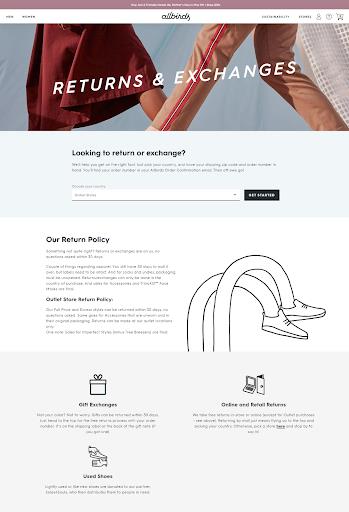
Returns are better viewed as an opportunity to flip a negative customer experience into a positive one. Seriously, a UPS study shows that 73% of shoppers say the returns experience influences how likely they are to buy again.
Creating a reasonable return policy. Display it clearly on your eCommerce homepage, footer, menus and check-out pages. Design it so that it protects your margins while also offering customers a fair deal. Do that and you’ll be well on your way to slashing post-purchase dissonance and building genuine customer loyalty.
4. Optimize Your Order Confirmation & Shipping Emails
One of the easiest ways to reassure customers they made the right decision is to send transactional emails.
We all know the feeling of buying something online and then frantically refreshing your inbox in search of confirmation email.
Similarly, leaving customers in the dark about shipping is a sure fire way to spark doubt and regret over their purchase.
The main goals of your transactional emails are to:
- Tell shoppers that you’ve received their order
- Let them know when it will arrive
Here’s a really great example from craft marketplace Etsy:
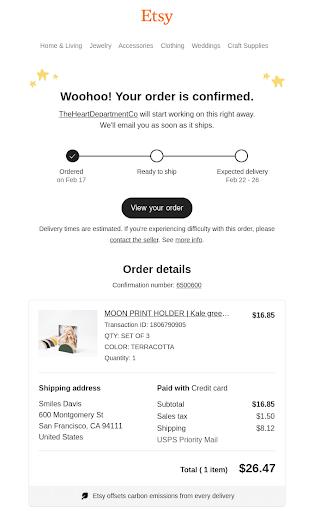
Notice how Etsy lays out everything clearly – what’s ordered, shipping times, returns, order cancellations and so on.
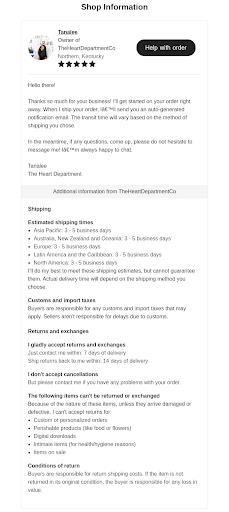
This level of transparency banishes regretul feelings and makes customers feel at ease about their order. Plus as an added benefit, supplying information up front reduces the burden on Etsy’s support.
5. Build a Post-Purchase Retention Flow
The next step is to go beyond basic transactional emails and build a nurturing flow for new customers.
Such onboarding email flows are more often associated with the world of Saas, but there’s no reason why you can’t leverage them in eCommerce too.
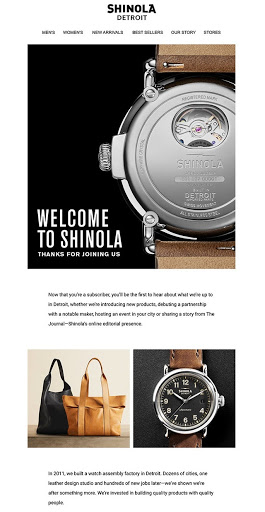
The goal with your post-purchase flow is to move shoppers closer to your brand and boost customer retention. These emails should be focused on value, not sales. For example, you can try sending customers links to your best blog content.
In addition to content, customer testimonials are also a powerful way to reduce post-purchase anxiety and reassure customers they made the right choice.
To kick things up a notch, you can even build out personalized campaigns based on what customers have ordered.
For example, let’s suppose someone buys a beard trimmer from your site. Imagine how impressed your customer would be if you sent them tips and tricks to get the most out of the trimmer before it even arrives.
Another way to use your post-purchase flow is to manage customer expectations. For example, imagine that you sell tubs of natural peanut butter.
It’s important to educate your customer’s that oil separation is normal and that they’ll need to stir the peanut butter for proper consistency.
Customers who don’t know this might end up thinking you’ve sent them a spoiled product and regret their decision to buy it.
The bottom line is that post-purchase emails can impact how your customers feel about their order. Deploying emails that subtly wash away post-purchase dissonance is a powerful strategy worth implementing.
6. Design a Killer Unboxing Experience
The nature of eCommerce makes the unboxing experience extremely important.
Seriously, the anticipation your customer’s feel before their order arrives means that unboxing is a critical moment for how they feel about your products.
Unlike brick and mortar retail, unboxing is the first time customer’s physically interact with your products. So, if you can go above and beyond their expectations, you can do alot to prevent heavy feelings of dissonance.
Since customer’s can’t interact with products in real life before purchasing, then unboxing is the one shot you have at delivering a wow moment.
If you’ve ever unboxed a new phone (particularly an iphone) you’ll know how much these tech companies invest in the experience.
Everything from pre-charging your device to the satisfying ‘pop’ as you open the box is deliberately pre-planned.
Now, you don’t have to go to such extremes. Thankfully, the bar for unboxing is very low. Most brands haven’t even thought about unboxing as a priority.
Obviously, your unboxing strategy depends on what you’re selling and your brand in general. But just a tiny amount of effort can go a long way.
For example, suppose you sell high ticket items like guitars. Adding in a low-cost item like a free plectrum or a set of strings will delight customers and remind them that they made the right purchasing decision.
If you’re not doing hundreds of orders per day, another easy way to create a memorable unboxing experience is to add a handwritten note, like Enrich and Endure do:
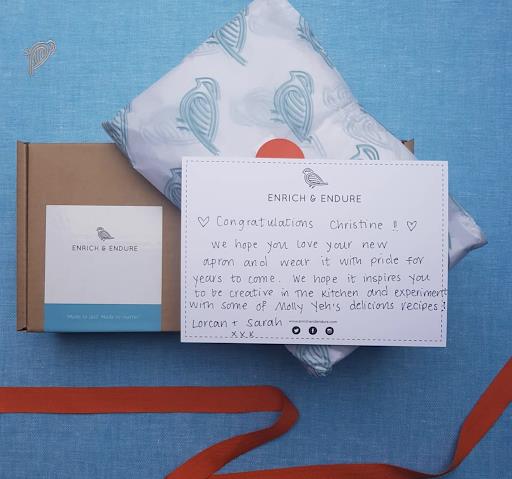
Source
Unboxing alone mightn’t be enough to eliminate customer regret. But when deployed in combination with the other 5 tactics, it’s a powerful way to attenuate dissonance and win a customer for life.
Go Forth & Deliver a Dissonance-Free Post-Purchase Experience
Hopefully by now you understand the importance of tackling post-purchase dissonance and have ideas about how to do it.
Remember that the key to reducing post-purchase dissonance is to start by figuring out what’s causing your customers to think twice about their purchase.
Once you know why customers are feeling bad about their order, you can build a strategy to address those concerns using the tactics we covered above.
Above all else, remember that reducing dissonance is an essential part of your retention strategy. Making customers feel good about their purchase is one of the best ways to keep them coming back for more.

Author Bio
This guest post was written by Fintan Meagher and the team at ReConvert. ReConvert is the easiest way to add thank you page upsells, cross-sells, surveys, and more to your Shopify store.
|<iframe style="width:120px;height:240px;" marginwidth="0" marginheight="0" scrolling="no" frameborder="0" src="//ws-na.amazon-adsystem.com/widgets/q?ServiceVersion=20070822&OneJS=1&Operation=GetAdHtml&MarketPlace=US&source=ss&ref=as_ss_li_til&ad_type=product_link&tracking_id=coaching054-20&language=en_US&marketplace=amazon®ion=US&placement=B085GM5WMG&asins=B085GM5WMG&linkId=6843153c05bd8c1994d613db6ccb3cca&show_border=true&link_opens_in_new_window=true"></iframe>|_____________________
By: Fintan Meagher
Title: 6 Battle-Tested Strategies to Reduce Post Purchase Dissonance (And Create Happier Customers)
Sourced From: www.become.co/blog/reduce-post-purchase-dissonance/
Published Date: Wed, 14 Jul 2021 08:24:28 +0000






